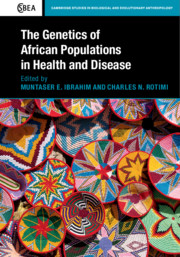Book contents
- The Genetics of African Populations in Health and Disease
- Cambridge Studies in Biological and Evolutionary Anthropology
- The Genetics of African Populations in Health and Disease
- Copyright page
- Contents
- Contributors
- 1 Reflections on Conceptualizing Africa for Biological Studies with a Historical Component
- 2 History and Genetics in Africa
- 3 Disease, Selection, and Evolution in the African Landscape
- 4 Genetic Susceptibility to Visceral Leishmaniasis
- 5 Genetics of Infection in Sub-Saharan Africa
- 6 Pharmacogenomics and Infectious Diseases in Africa
- 7 A Glimpse into Pharmacogenomics in Africa
- 8 Genomics of Cardiometabolic Disorders in Sub-Saharan Africa
- 9 Breast Cancer in African Populations
- 10 Sociobiological Transition and Cancer
- 11 The Genetic Epidemiology of Orphan Diseases in North Africa
- 12 Birth Defects and Genetic Disease in Sub-Saharan Africa
- 13 Neurogenetic Disorders in Africa: Hereditary Spastic Paraplegia
- 14 Enabling Genomic Revolution in Africa
- Index
- References
5 - Genetics of Infection in Sub-Saharan Africa
What Can the Study of Mendelian Immunodeficiency Disorders Contribute?
Published online by Cambridge University Press: 02 December 2019
- The Genetics of African Populations in Health and Disease
- Cambridge Studies in Biological and Evolutionary Anthropology
- The Genetics of African Populations in Health and Disease
- Copyright page
- Contents
- Contributors
- 1 Reflections on Conceptualizing Africa for Biological Studies with a Historical Component
- 2 History and Genetics in Africa
- 3 Disease, Selection, and Evolution in the African Landscape
- 4 Genetic Susceptibility to Visceral Leishmaniasis
- 5 Genetics of Infection in Sub-Saharan Africa
- 6 Pharmacogenomics and Infectious Diseases in Africa
- 7 A Glimpse into Pharmacogenomics in Africa
- 8 Genomics of Cardiometabolic Disorders in Sub-Saharan Africa
- 9 Breast Cancer in African Populations
- 10 Sociobiological Transition and Cancer
- 11 The Genetic Epidemiology of Orphan Diseases in North Africa
- 12 Birth Defects and Genetic Disease in Sub-Saharan Africa
- 13 Neurogenetic Disorders in Africa: Hereditary Spastic Paraplegia
- 14 Enabling Genomic Revolution in Africa
- Index
- References
Summary
While non-communicable diseases have overtaken infectious diseases as the leading cause of mortality and morbidity globally, the burden of infectious diseases remains disproportionately high in sub-Saharan Africa (SSA) compared to other regions. Despite improvements in the prevention and control of certain infectious diseases, driven in particular by the sixth Millennium Development Goal – to combat HIV/AIDS, malaria, and other diseases – the burden of infectious diseases remains high. In 2017 it was estimated that 1.18 million people died from tuberculosis (TB) and 619,800 from malaria (GBD 2017 Mortality and Causes of Death Collaborators, 2018). HIV/AIDS remains a major cause of premature death in SSA (954,500 deaths in 2017), despite the availability of effective anti-retroviral treatment. Despite gains in life expectancy in SSA due to reduction in diarrheal and lower respiratory tract infections in children, 808,900 died from lower respiratory tract infections, and 553,800 from diarrheal diseases, and 153,100 from meningitis in 2017.
- Type
- Chapter
- Information
- Publisher: Cambridge University PressPrint publication year: 2019



